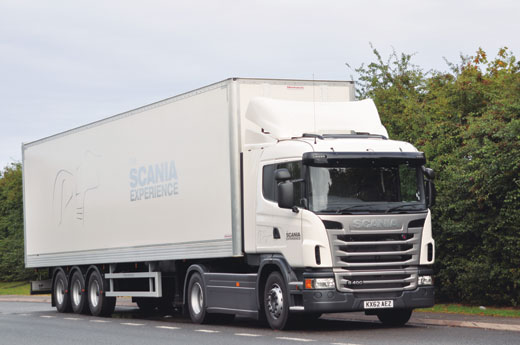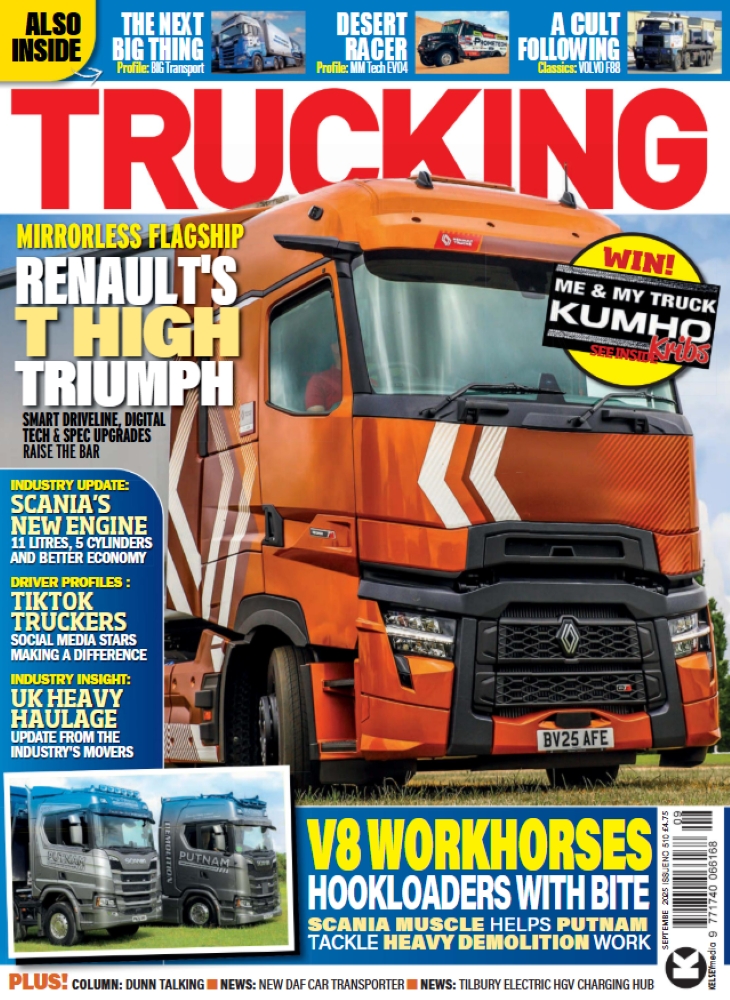
Truck manufacturers tend to spot gaps – or a need for further chassis offerings – in their product lineups once they have been in production for a while.
Generally, the influence for this comes from customers who are looking for – in some cases – a truck to service a specific operation. At other times, manufacturers can get away with offering a chassis suited to virtually any operation.
Think of the Mercedes-Benz Axor, a truck that came from customer requests for a fleet-spec truck that would suit the supermarket operators. A basic truck that any driver could hop into and drive without needing any training, whereas, with the Actros, many of the big fleet customers felt drivers needed educating in how to operate the transmission etc. They were deemed too complicated for fleet work.
These operators generally run their trucks around the clock – many of them rarely stopping for longer than it takes for a driver and trailer changeover. Getting a driver familiar with the methodology of electronically-operated automated transmissions and to take new drivers (or more often than not at that time, agency drivers) up the road for a spin to explain the intricacies of an automated transmission during the day probably isn’t too much of a problem. But operations that run 24/7 would find that difficult if not impossible once the transport offices have closed. Then it becomes difficult to implement. So the Axor was born – a truck designed specifically for the big fleets, with a standard sleeper cab, basic layout and interior and manual transmission.

But at the other end of the scale is the all-rounder – a truck that must fit the bill in a variety of roles. And that’s what Scania’s G-series is. Available with five cab variants, comprising three sleepers, a day cab and a short cab, they represent an option between the P-series and R-series – increased driver comfort over the P-series, as well as more engine and gearbox options.
Scania claims whether an operator wants a truck for a specific and specialized single purpose, or multi-function role, the G-series is the truck to go for.
On the road
Climb up into the cab using the angled steps and you find yourself behind the wheel of a truck that has been specifically designed to suit different drivers’ styles of positioning.
Dubbed either ‘upright’ (which is considered the ‘normal’ seating/driving position), or ‘Formula 1’, which is more laid back and needs a steering wheel/column that can be set at a lower and more angled position, Scania has ensured its trucks suit either preference.
My preference is the upright or normal position, and with the Normal sleeper cab option fitted here, there is enough roof height to give the driver a feeling of spaciousness. There’s a semi-flat floor on this model, which the driver can step across when he’s moving around inside the cab, and it doesn’t present much of an obstacle. But to dress/undress, you need to stand in the foot well on the passenger side to give yourself enough room to be able to stand almost upright.
The dash is typically Scania – a functional, wrap-round, ergonomically-designed area that puts everything the driver needs right there in front of him. Once he climbs out from behind the steering wheel, he’s literally away from his workplace. It’s a simple idea that works remarkably well.
Electrically-operated window and mirror adjustment/heater controls are located on the door top, handily situated right where the driver naturally rests his arm. Vents along this area not only keep the window clear, but can also act as hand/arm heaters/coolers, depending on the time of year!
This truck was fitted with the Scania turbocharged and intercooled direct injection diesel DC-13-05, Euro 5, 13-litre in-line six cylinder engine, equipped with Scania XPi and using selective catalytic reduction (SCR) technology. Rated at 400 bhp, the truck’s performance proved more than adequate.
The 12-speed transmission was fitted with Scania’s two-pedal Opticruise automated gearchanging option. Using it couldn’t be simpler. Twist the collar on the stubby stalk on the right-hand side of the steering column to ‘D’ (Drive), off with the parking brake, press the gas pedal and you are off.
We took the truck on a mixed route, but steered clear of the motorway because of dire warnings about congestion following a serious accident. However, a stint on the A5 dual carriageway gave as good an account of how the truck would generally perform on a motorway as was needed.

Using cruise control as much as possible, and leaving the truck in automated gearchanges – except for one instance where the driver took over after selecting manual – we aimed to see just how good the Opticruise transmission is, while minimizing fuel usage, squeezing best performance and maximizing driver comfort during the trip.
We stuck to the speed limits (just as well as we encountered two speed traps courtesy of the so-called ‘Safety Partnership’ camera vans), setting the cruise control to 50 mph (just over 80 kmh) for the dual carriageway sections, and 40 mph (around 65 kmh) for the A-roads.
On the road, the Scania’s performance was well above average for a truck perfectly-matched to the 10 bhp-per-tonne standard (a 4×2 tractor with three-axle trailer grossing 40 tonnes). We eased the truck away from standing starts to keep the fuel usage down, slowing at junctions and the many roundabouts heading out of and then back into Milton Keynes, where Scania (Great Britain) Limited has its headquarters, to keep the truck moving should there be a gap in the traffic. But something you do notice more when you are in a truck, particularly when you are trying to maintain decent fuel consumption by not stopping at roundabouts etc, is how many car drivers do not indicate where they are going. We came to a halt unnecessarily on several occasions because of cars which appeared to be continuing on around a roundabout, or going straight on past junctions we were emerging from, only to turn into that junction, or leave the roundabout at the road we were approaching from without using their indicators. It’s infuriating, but sadly is becoming much more commonplace now.
Being an ex-tanker driver, I tend to treat roundabouts with respect anyway. Just as well on this occasion, as we encountered several with adverse cambers that could potentially catch out the unwary.
Scania mirrors have a reputation as being some of the best in the business, and those on this truck carried on that tradition. The main mirrors create minimal blindspots (narrow A-pillars help), while well-placed convex mirrors above the main mirrors on either side give excellent back-up views along the side of the truck up to the doors and into the distance. The distance view is an advantage on long, empty open roads as you can spot cars approaching from way back, giving the driver an advantage should he be about to make a manoeuvre, or if he needs to change lanes for any reason
This truck’s handling is faultless. You don’t have to go far to find bad road surfaces now. We don’t actively seek them out, but they are a good judge of a truck’s steering and suspension characteristics. They also test whether a truck’s cab/seating suspension arrangements are adequate.
Volvo announced (optional) independent front suspension in its new FH, aimed at reducing yaw and the possibility of the truck being sent off the road by wrenching the steering as the truck encounters potholes or falling roadside edges. We encountered roads like this in the Scania and the truck didn’t flinch or give the driver any scares whatever the road surface. On one stretch from Buckingham to Bicester, equally-spaced drains run along both sides of the road – clearly a road that floods regularly – and they have all sunk, probably through the sheer weight of traffic using this busy stretch. There are also stretches that have sunk away, causing a sudden change in the road surface. But whatever we came across, the steering was unaffected, the truck sticking to the course without flinching.
An added advantage with the Opticruise transmission and cruise control on this truck is the Active Prediction option. The electronics are fed information via GPS of the route up to 3 km ahead, and the transmission reacts accordingly. Scania claims it improves the driving experience by literally telling the truck the topography ahead, so it is prepared, smoothing out gearchanges. We didn’t notice if this worked while we were out on the road, but as Scania said, you shouldn’t notice, because that’s the aim of the technology!
At one point, when crossing from the A422 up to the A421 in Buckingham via a roundabout that is atop a ramp, with a short flat section then another climb after it, the gearchanges were exceptionally smooth. The transmission appeared to know exactly what to do under the circumstances, proving the driver can leave the Opticruise gear selection to just get on with it for most of the time.
Incidentally, Scania has a wealth of driver aids and information that can be accessed via the driver info panel on the main dash. Scania Driver Support informs the driver of his driving style and prompts him to improve. For example, slow on the approach to a roundabout and manage to slot yourself in without stopping, with gentle use of the brake and gas pedals, and you are treated to five stars on the dash readout! The truck actively encourages drivers to better themselves.
The brakes are perfect, with good feel and strong slowing power, the steering lock excellent, making shunting around in tight yards easy. On the road, engine noise is minimal, and even the audible indicator warning has been given a gentle ‘plip-plop’ sound – just enough to inform the driver should they not cancel, but not enough to be annoying.
There’s a decent level of luxury with this truck. The switches have a good feel to them, they operate well, and the door levers are nice and chunky and feel robust, while the doors have three opening angles – the check-strap holding them at three different positions. The Scania appears to be fairly well-endowed in the storage department. There are enough storage bins and pockets dotted around (an under-bunk drawer as fitted here can be spec’d as a fridge instead if required) with some useful over-screen lockers, and the bunk is nice and comfortable.
Verdict
To say the G-series Scania simply straddles the P-series and R-series is to underestimate just what the Swedish truck manufacturer has achieved. This is a truck in its own right, and a pretty formidable one at that.
This particular truck, fitted with the Normal sleeper, offers bags of comfort and there’s enough interior space for a driver to spend multiple nights away from base, and to be able to undertake varied types of work. True, the truck isn’t suitable for use as a max-load car transporter tractor, for example, but its dimensions mean it is low enough to access drive-through agricultural or aggregates hoppers.
The chassis is robust and the drivetrain is suited to running on bad road surfaces. So a lot of rural deliveries to remote areas wouldn’t be problem with this truck. Opticruise takes care of the gearchanges, ensuring the driver can keep his eyes on the road and his hands on the wheel, while the electronic aids fitted will ensure the driver operates the truck for maximum profitability.
The only thing we would go for, particularly if we were regularly working in hilly areas, would be a bit more power to cope with the terrain.






